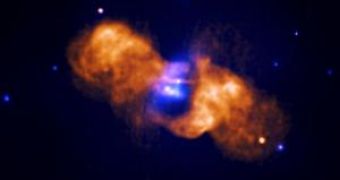The emissions of hot jets and gas from a distant galaxy are yielding an odd interaction between radio and X-ray signals.
The galaxy, known as 3C442A, sits about 390 million light-years from Earth towards the constellation Pegasus.
Astronomers believe that supermassive black holes at the center of most galaxies (millions or even billions of times more massive than the Sun) shape their environment by generating jets of high-energy particles that can shine in bright radio waves. These radio "hot" signals are typically seen to push around hot gas to create immense cavities or powerful shock fronts that can be seen in X-ray observations.
But in 3C442A, the reverse is true. It is X-ray emitting gas that is pushing apart its radio bright counterparts.
Observations from the space-based NASA's Chandra X-ray Observatory and Very Large Array on Earth found that the hot gas (blue) in the middle of 3C442A is pushing apart the radio-bright gas (orange). The inner sections of the radio structure are sharp and concave, which is consistent with the idea that the X-ray bright gas is sweeping the radio-emitting gas aside. This is the first convincing evidence for such a role reversal.
There are actually two galaxies within 3C442A, which are in the process of merging and have already one close pass on the road to collision.
The energy from the merging process is prompting both galaxies to shine bright in X-rays, though their lobes of radio-emitting gas are no longer active, astronomers said. The jets may have ceased at the time of - and possibly as a result of - the galaxy collision. Since the radio-emitting gas no longer has a power source, it is then at the mercy of the expanding hot gas and has been pushed aside.

 14 DAY TRIAL //
14 DAY TRIAL //